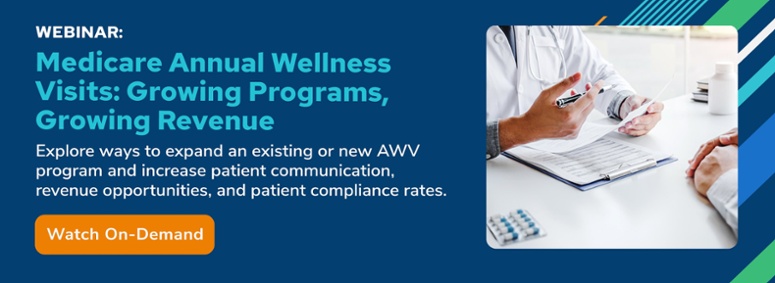As the healthcare industry continues to look for ways to improve patient health while also controlling the ever-rising cost of quality healthcare, preventive screening has become an increasingly important topic.Preventive screenings, along with other preventive services, are often viewed by medical practices, insurance providers, and even patients as long-term investments. This attitude is a result of the understanding that keeping people healthy is not only best for the patient’s well-being; it is more cost-effective than treating the symptoms of an illness that has already developed.
In addition to money, preventive medicine has the potential to save lives. According to the Centers for Disease Control and Prevention, “If everyone in the US received recommended clinical preventive care we could save over 100,000 lives each year.”
Though preventive screening is viewed positively in the industry and even encouraged by both government policy and insurance providers, there are many challenges when it comes to implementing a preventive screening program in a traditional medical practice.
How to Help Everyone Access Preventive Screenings
The first hurdle is the universal need for these preventive services. Some form of screening recommendation exists for every demographic. Even generally healthy adults are encouraged to see their healthcare providers every 1-3 years to assess their current health and identify any risks for future health complications.
Though the need for preventive health screening applies to all patients, the actual implementation of screening strategies is specific to each patient. Just a brief list of available services includes screenings for conditions such as depression, alcohol abuse, cardiovascular risk, cardiovascular disease, cognitive impairment, diabetes, aortic aneurysm, and colorectal cancer.
Whether or not it is necessary to screen for these and many other conditions, depends on factors such as the age, gender, and lifestyle choices of the patient. So, selecting the best preventive screening options must be done on an individual basis.
Not only do the individual health needs of patients vary, so do the eligibility requirements that dictate what preventive services are accessible through their health coverage. Every health insurance provider uses different guidelines and recommendations to develop their eligibility requirements. There can also be a great deal of variation between different coverage plans within the same insurance provider.
In addition, these policies change regularly as insurance providers update and modify their company policies. As a result, patient eligibility must be verified with each service to prevent patients from missing out on available screenings and prevent medical practices from unintentionally performing preventive screenings for which they will not be reimbursed.
The resources required to assess the needs and eligibility of each patient manually make the full use of preventive screenings extremely difficult and costly. The solution is a platform that automatically compares the individual health history of a patient against available preventive services and insurance coverage eligibility. With an easily accessible report available to medical providers, preventive health screenings are more likely to occur as well as cost-effective.
How to Increase Efficiency and Patient Involvement
Most patients understand that completing preventive screenings is an important step in staying healthy. However, they generally do not take the lead on their care and simply rely on their healthcare providers to let them know which services they should be receiving and when. The problem with this approach is that even when a doctor takes responsibility for preventive care, the active participation of the patient is still required to ensure that they have access to all of the preventive screenings that they need.
An important step for both identifying available preventive screening options, and even completing some screening assessments, is for patients to complete forms and fill out written questionnaires. But the busy schedules of a medical practice make the one-on-one time required for completing these forms in office difficult or even prohibitive. This is particularly true if a patient comes to their appointments unprepared with the information they may need for the process.
The amount of time needed to assess the screening needs of a patient accurately multiplies if a medical practice relies on handwritten forms. These paper-based documents are time-consuming for the patient to complete and equally time consuming for the practice staff to input into a billing or EHR system. Handwritten forms also increase the risk of human error in the recording process, which may result in incorrect records, in addition to inaccurate need and eligibility assessments.
Providing a resource for patients to complete any necessary forms or assessments in a digital environment, and often before they even come into the office, allows for the most efficient use of time for both the provider and the patient. Digital forms also allow integration with other medical software, reducing the administrative time needed to process forms and reducing the risk of human error.
How to Ensure Practices Can Be Reimbursed
Coding and billing for each service is often one of the most time-consuming tasks at a medical practice. When preventive services are included, this process can become even more complicated. Programs like the Merit-based Incentive Payment System (MIPS) exist to encourage quality healthcare practices, such as preventive medicine, through a financial incentive program. But the actual process of maintaining compliance through the program-specific reporting can take more resources than the incentives are worth.
The rules and guidelines surrounding Medicare Annual Wellness Visits are also known for being complex and potentially confusing. This means that healthcare practices may be using extra resources to complete the reporting and billing process for these visits or even missing out on available revenue altogether. The importance of full compliance with these complex rules adds to the challenge. A medical practice may be reimbursed initially, but later be forced to return the funds when they are found non-compliant during an audit.
A resource that helps reduce the administrative workload of medical staff, as well as ensures compliance with reporting and billing guidelines, is an essential part of making sure that the potential revenue of preventive screenings is worthwhile for a medical practice.
Technology is the key to solve all of these challenges and realize the vast health benefits of preventive screening for patients, while also making these services efficient and cost-effective for medical practices.
If you’re looking for an ideal solution that solves the issues we shared here, discover how Prevounce gives medical practices the tools they need to efficiently and accurately assess patients, verify eligibility, remain program compliant, and manage claims so that your patients receive the best possible care, and your practice can see the promised revenue of preventive care.

